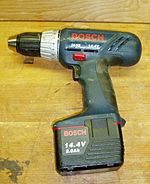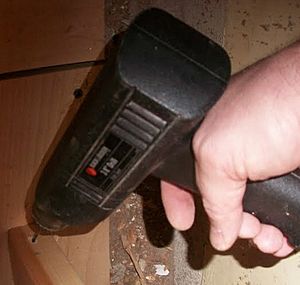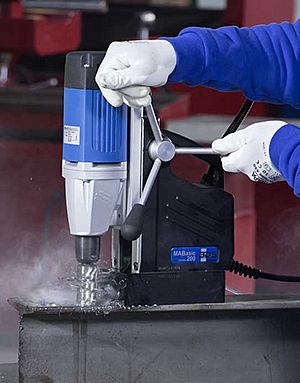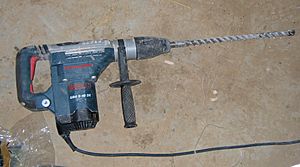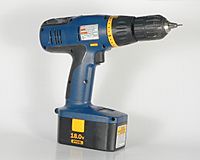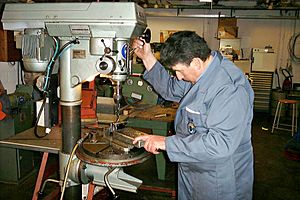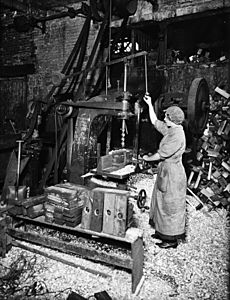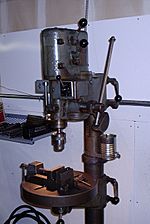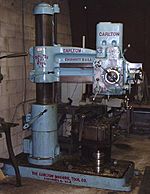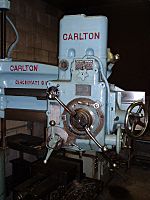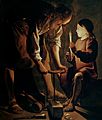Drill facts for kids
A drill is a type of electrical tool that has a spinning tip. It can be used for many different jobs depending on the attachment. If a drill bit is attached, the drill can be used to make holes in material. A driver bit can also be attached, allowing the drill to put screws into the desired material. A drill can run on a battery or be plugged into the wall, depending on the drill.
Contents
History
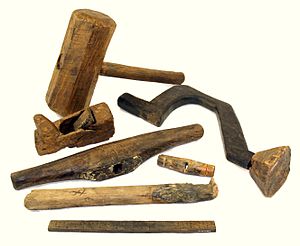
Around 35,000 BC, Homo sapiens discovered the benefits of the application of rotary tools. This would have rudimentarily consisted of a pointed rock being spun between the hands to bore a hole through another material. This led to the hand drill, a smooth stick, that was sometimes attached to flint point, and was rubbed between the palms. This was used by many ancient civilizations around the world including the Mayans. The earliest perforated artifacts, such as bone, ivory, shells and antlers found, are from the Upper Paleolithic era.
Bow drill (strap-drills) are the first machine drills, as they convert a back and forth motion to a rotary motion, and they can be traced back to around 10,000 years ago. It was discovered that tying a cord around a stick, and then attaching the ends of the string to the ends of a stick(a bow), allowed a user to drill quicker and more efficiently. Mainly used to create fire, bow-drills were also used in ancient woodwork, stonework and dentistry. Archaeologists discovered a Neolithic grave yard in Mehrgrath, Pakistan dating from the time of the Harappans, around 7,500–9,000 years ago, containing 9 adult bodies with a total of 11 teeth that had been drilled. There are hieroglyphs depicting Egyptian carpenters and bead makers in a tomb at Thebes using bow-drills. The earliest evidence of these tools being used in Egypt dates back to around 2500 BCE. The usage of bow-drills was widely spread through Europe, Africa, Asia and North America, during ancient times and is still used today. Over the years many slight variations of bow and strap drills have developed for the various uses of either boring through materials or lighting fires.
The core drill was developed in ancient Egypt by 3000 BC(5016 years before now). The pump drill was invented during Roman times. It consists of a vertical spindle aligned by a piece of horizontal wood and a flywheel to maintain accuracy and momentum.
The hollow-borer tip, first used around the 13th century, consisted of a stick with a tubular shaped piece of metal on the end, such as copper. This allowed a hole to be drilled while only actually grinding the outer section of it. This completely separates the inner stone or wood from the rest, allowing the drill to pulverize less material to create a similarly sized hole.
While the pump-drill and the bow-drill were used in Western Civilization to bore smaller holes for a larger part of human history, the Auger was used to drill larger holes starting sometime between Roman and Medieval ages. The auger allowed for more torque for larger holes. It is uncertain when the Brace and Bit was invented; however, the earliest picture found so far dates from the 15th century. It is a type of hand crank drill that consists of two parts as seen in the picture. The brace, on the upper half, is where the user holds and turns it and on the lower part is the bit. The bit is interchangeable as bits wear down. The auger uses a rotating helical screw similar to the Archimedean screw-shaped bit that is common today. The gimlet is also worth mentioning as it is a scaled down version of an auger.
In the East, churn drills were invented as early as 221 BC during the Chinese Qin Dynasty, capable of reaching a depth of 1500 m. Churn drills in ancient China were built of wood and labor-intensive, but were able to go through solid rock. The churn drill appears in Europe during the 12th century. In 1835 Isaac Singer is reported to have built a steam powered churn drill based off the method the Chinese used. Also worth briefly discussing are the early drill presses; they were machine tools that derived from bow-drills but were powered by windmills and water wheels. Drill presses consisted of the powered drills that could be raised or lowered into a material, allowing for less force by the user.
The next great advancement in drilling technology, the electric motor, led to the invention of the electric drill. It is credited to Arthur James Arnot and William Blanch Brain of Melbourne, Australia who patented the electric drill in 1889. In 1895, the first portable handheld drill was created by brothers Wilhem & Carl Fein of Stuttgart, Germany. In 1917 the first trigger-switch, pistol-grip portable drill was patented by Black & Decker. This was the start of the modern drill era. Over the last century the electric drill has been created in a variety of types and multiple sizes for an assortment of specific uses.
Types
There are many types of drills: some are powered manually, others use electricity (electric drill) or compressed air (pneumatic drill) as the motive power, and a minority are driven by an internal combustion engine (for example, earth drilling augers). Drills with a percussive action (hammer drills) are mostly used in hard materials such as masonry (brick, concrete and stone) or rock. Drilling rigs are used to bore holes in the earth to obtain water or oil. Oil wells, water wells, or holes for geothermal heating are created with large drilling rigs. Some types of hand-held drills are also used to drive screws and other fasteners. Some small appliances that have no motor of their own may be drill-powered, such as small pumps, grinders, etc.
Hand drills
A variety of hand-powered drills have been employed over the centuries. Here are a few, starting with approximately the oldest:
- Bow drill
- Brace and bit
- Gimlet
- Hand drill, also known as an "eggbeater" drill, or (especially in the UK) a wheel brace
- Breast drill, similar to an "eggbeater" drill, it has a flat chest piece instead of a handle
- Push drill, a tool using a spiral ratchet mechanism
- Pin chuck, a small hand-held jeweler's drill
Pistol-grip (corded) drill
Drills with pistol grips are the most common type in use today, and are available in a huge variety of subtypes. A less common type is the right-angle drill, a special tool used by tradesmen such as plumbers and electricians. The motor used in corded drills is often a universal motor due to its high power to weight ratio.
For much of the 20th century, many attachments could commonly be purchased to convert corded electric hand drills into a range of other power tools, such as orbital sanders and power saws, more cheaply than purchasing conventional, self-contained versions of those tools (the greatest saving being the lack of an additional electric motor for each device). As the prices of power tools and suitable electric motors have fallen, however, such attachments have become much less common. A similar practice is currently employed for cordless tools where the battery, the most expensive component, is shared between various motorised devices, as opposed to a single electric motor being shared between mechanical attachments.
Hammer drill
The hammer drill is similar to a standard electric drill, with the exception that it is provided with a hammer action for drilling masonry. The hammer action may be engaged or disengaged as required. Most electric hammer drills are rated (input power) at between 600 and 1100 watts. The efficiency is usually 50-60% i.e. 1000 watts of input is converted into 500-600 watts of output (rotation of the drill and hammering action).
The hammer action is provided by two cam plates that make the chuck rapidly pulse forward and backward as the drill spins on its axis. This pulsing (hammering) action is measured in Blows Per Minute (BPM) with 10,000 or more BPMs being common. Because the combined mass of the chuck and bit is comparable to that of the body of the drill, the energy transfer is inefficient and can sometimes make it difficult for larger bits to penetrate harder materials such as poured concrete. The operator experiences considerable vibration, and the cams are generally made from hardened steel to avoid them wearing out quickly. In practice, drills are restricted to standard masonry bits up to 13 mm (1/2 inch) in diameter. A typical application for a hammer drill is installing electrical boxes, conduit straps or shelves in concrete.
In contrast to the cam-type hammer drill, a rotary/pneumatic hammer drill accelerates only the bit. This is accomplished through a piston design, rather than a spinning cam. Rotary hammers have much less vibration and penetrate most building materials. They can also be used as "drill only" or as "hammer only" which extends their usefulness for tasks such as chipping brick or concrete. Hole drilling progress is greatly superior to cam-type hammer drills, and these drills are generally used for holes of 19 mm (3/4 inch) or greater in size. A typical application for a rotary hammer drill is boring large holes for lag bolts in foundations, or installing large lead anchors in concrete for handrails or benches.
Magnetic Drilling Machine
A Magnetic Drilling Machine is a machine tool used for drilling holes in variety of metals. It is a portable drilling machine with a base or a permanent magnet base. It drills holes with the help of cutting tools like annular cutters (broach cutters) or with twist drill bits. There are various types depending on their operations and specialisations like magnetic drilling cum tapping machines, cordless, pneumatic, compact horizontal, automatic feed, cross table base etc.
It is also popularly known as a magnetic core drilling machine, magnetic base drilling machine, mag base drilling machine, mag base, magnetic broach cutter machine, magnetic drill ormag drill.
A portable magnetic drilling machine is the best solution for drilling large and heavy workpieces which are difficult to move or bring to the stationary conventional drilling machine for making holes, where as the magnetic drilling machines are so portable and lightweight that the machines can be taken to the workpiece to be drilled. They have popularly changed the method of bringing workpiece to the machine to bringing the machine to the workpiece.
Rotary hammer drill
The rotary hammer drill (also known as a rotary hammer, roto hammer drill or masonry drill) combines a primary dedicated hammer mechanism with a separate rotation mechanism, and is used for more substantial material such as masonry or concrete. Generally, standard chucks and drills are inadequate and chucks such as SDS and carbide drills that have been designed to withstand the percussive forces are used. Some styles of this tool are intended for masonry drilling only and the hammer action cannot be disengaged. Other styles allow the drill to be used without the hammer action for normal drilling, or hammering to be used without rotation for chiselling. In 1813 Richard Trevithick designed a steam-driven rotary drill, also the first drill to be powered by steam.
Cordless drills
A cordless drill is an electric drill which uses rechargeable batteries. These drills are available with similar features to an AC mains-powered drill. These are the most common type of drill. They are available in the hammer drill configuration and most have a clutch, which aids in driving screws into various substrates while not damaging them. Also available are right angle drills, which allow a worker to drive screws in a tight space. While 21st century battery innovations allow significantly more drilling, large diameter holes (typically 12–25 mm (0.5–1.0 in) or larger) may drain current cordless drills quickly.
For continuous use, a worker will have one or more spare battery packs charging while drilling, and quickly swap them instead of having to wait an hour or more for recharging, although there are now Rapid Charge Batteries that can charge in 10–15 minutes.
Early cordless drills used interchangeable 7.2 V battery packs. Over the years battery voltages have increased, with 18 V drills being most common, but higher voltages are available, such as 24 V, 28 V, and 36 V. This allows these tools to produce as much torque as some corded drills.
Common battery types of are nickel-cadmium (NiCd) batteries and lithium-ion batteries, with each holding about half the market share. NiCd batteries have been around longer, so they are less expensive (their main advantage), but have more disadvantages compared to lithium-ion batteries. NiCd disadvantages are limited life, self-discharging, environment problems upon disposal, and eventually internally short circuiting due to dendrite growth. Lithium-ion batteries are becoming more common because of their short charging time, longer life, absence of memory effect, and low weight. Instead of charging a tool for an hour to get 20 minutes of use, 20 minutes of charge can run the tool for an hour. Lithium-ion batteries also hold a charge for a significantly longer time than nickel-cadmium batteries, about two years if not used, vs. 1 to 4 months for a nickel-cadmium battery.
Drill press
A drill press (also known as a pedestal drill, pillar drill, or bench drill) is a fixed style of drill that may be mounted on a stand or bolted to the floor or workbench. Portable models with a magnetic base grip the steel workpieces they drill. A drill press consists of a base, column (or pillar), table, spindle (or quill), and drill head, usually driven by an induction motor. The head has a set of handles (usually 3) radiating from a central hub that, when turned, move the spindle and chuck vertically, parallel to the axis of the column. The drill press is typically measured in terms of swing. Swing is defined as twice the throat distance, which is the distance from the center of the spindle to the closest edge of the pillar. For example, a 16-inch (410 mm) drill press has an 8-inch (200 mm) throat distance.
A drill press has a number of advantages over a hand-held drill:
- Less effort is required to apply the drill to the workpiece. The movement of the chuck and spindle is by a lever working on a rack and pinion, which gives the operator considerable mechanical advantage
- The table allows a vise or clamp to be used to position and restrain the work, making the operation much more secure
- The angle of the spindle is fixed relative to the table, allowing holes to be drilled accurately and consistently
- Drill presses are almost always equipped with more powerful motors compared to hand-held drills. This enables larger drill bits to be used and also speeds up drilling with smaller bits.
For most drill presses—especially those meant for woodworking or home use—speed change is achieved by manually moving a belt across a stepped pulley arrangement. Some drill presses add a third stepped pulley to increase the number of available speeds. Modern drill presses can, however, use a variable-speed motor in conjunction with the stepped-pulley system. Medium-duty drill presses such as those used in machine shop (tool room) applications are equipped with a continuously variable transmission. This mechanism is based on variable-diameter pulleys driving a wide, heavy-duty belt. This gives a wide speed range as well as the ability to change speed while the machine is running. Heavy-duty drill presses used for metalworking are usually of the gear-head type described below.
Drill presses are often used for miscellaneous workshop tasks other than drilling holes. This includes sanding, honing, and polishing. These tasks can be performed by mounting sanding drums, honing wheels and various other rotating accessories in the chuck. This can be unsafe in some cases, as the chuck arbor, which may be retained in the spindle solely by the friction of a taper fit, may dislodge during operation if the side loads are too high.
Geared head drill press
A geared head drill press is a drill press in which power transmission from the motor to the spindle is achieved solely through spur gearing inside the machine's head. No friction elements (e.g., belts) of any kind are used, which assures a positive drive at all times and minimizes maintenance requirements. Gear head drills are intended for metalworking applications where the drilling forces are higher and the desired speed (RPM) is lower than that used for woodworking.
Levers attached to one side of the head are used to select different gear ratios to change the spindle speed, usually in conjunction with a two- or three-speed motor (this varies with the material). Most machines of this type are designed to be operated on three-phase electric power and are generally of more rugged construction than equivalently sized belt-driven units. Virtually all examples have geared racks for adjusting the table and head position on the column.
Geared head drill presses are commonly found in tool rooms and other commercial environments where a heavy duty machine capable of production drilling and quick setup changes is required. In most cases, the spindle is machined to accept Morse taper tooling for greater flexibility. Larger geared head drill presses are frequently fitted with power feed on the quill mechanism, with an arrangement to disengage the feed when a certain drill depth has been achieved or in the event of excessive travel. Some gear-head drill presses have the ability to perform tapping operations without the need for an external tapping attachment. This feature is commonplace on larger gear head drill presses. A clutch mechanism drives the tap into the part under power and then backs it out of the threaded hole once the proper depth is reached. Coolant systems are also common on these machines to prolong tool life under production conditions.
Radial arm drill press
A radial arm drill press is a large geared head drill press in which the head can be moved along an arm that radiates from the machine's column. As it is possible to swing the arm relative to the machine's base, a radial arm drill press is able to operate over a large area without having to reposition the workpiece. This saves considerable time because it is much faster to reposition the drill head than it is to unclamp, move, and then re-clamp the workpiece to the table. The size of work that can be handled may be considerable, as the arm can swing out of the way of the table, allowing an overhead crane or derrick to place a bulky workpiece on the table or base. A vise may be used with a radial arm drill press, but more often the workpiece is secured directly to the table or base, or is held in a fixture. Power spindle feed is nearly universal with these machines and coolant systems are common. Larger size machines often have power feed motors for elevating or moving the arm. The biggest radial arm drill presses are able to drill holes as large as four inches (101.6 millimeters) diameter in solid steel or cast iron. Radial arm drills are specified by the diameter of the column and the length of the arm. The length of the arm is usually the same as the maximum throat distance. The Radial Arm Drill pictured in this article is a 9-inch column x 3-foot arm. The maximum throat distance of this drill would be approximately 36", giving a swing of 72" (6 feet)..
Mill drill
Mill drills are a lighter alternative to a milling machine. They combine a drill press (belt driven) with the X/Y coordinate abilities of the milling machine's table and a locking collet that ensures that the cutting tool will not fall from the spindle when lateral forces are experienced against the bit. Although they are light in construction, they have the advantages of being space-saving and versatile as well as inexpensive, being suitable for light machining that may otherwise not be affordable.
Accessories
Drills are often used simply as motors to drive a variety of applications, in much the same way that tractors with generic PTOs are used to power ploughs, mowers, trailers, etc.
Accessories available for drills include:
- Screw-driving tips of various kinds - flathead, Philips, etc. for driving screws in or out
- Water pumps
- Nibblers for cutting metal sheet
- Rotary sanding discs
- Rotary polishing discs
Images for kids
-
Painting by Georges de La Tour of St. Joseph operating a drill.
See also
 In Spanish: Taladradora para niños
In Spanish: Taladradora para niños


